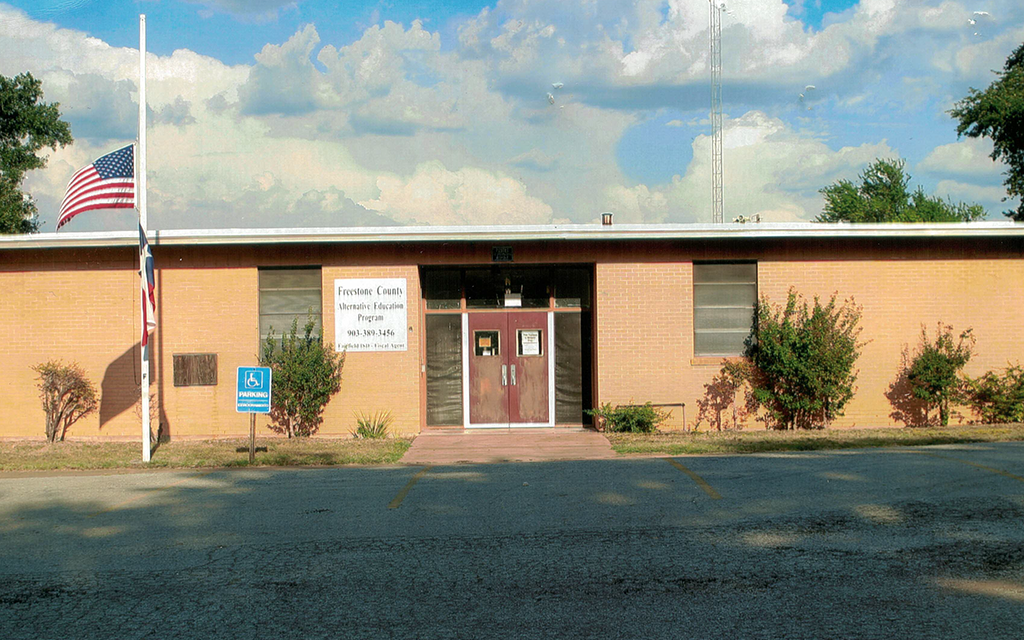With the recent sale of Fairfield Independent School District’s Dogan High School campus, one is reminded of this school’s history and legacy of educational achievements beginning in the mid 1920’s as a “colored” school in a community known as “The Flat”, an area directly across U.S. Highway 84 from Brookshire’s Grocery Store in Fairfield.
In 1926, the original “colored” school was started to educate a first through ninth grade curriculum (9 grade system) with only two teachers: Mae V. Donahue hired as the first principal/teacher and an additional teacher, Miss Pauline Johnson. It rapidly expanded with the influx of students from a growing black community and by 1927, a third teacher, Mrs. Inez Johnson was hired and in 1932, a fourth teacher, Mr. Equille Satchell was hired. As there was no more classroom space, Mr. Satchell used the sanctuary of the near-by Fairfield Baptist Church as a classroom. (Incidentally, the Fairfield Baptist Church was paid $10.00 a month for the use of its sanctuary by the school.)
With the growing need of more space to accommodate an increasing number of students, community leaders Billie Lorenzo McIlveen and Willie Solomon started fund raising by selling food and refreshments in the summers and scouting for cheap land in the Fairfield area to accommodate a bigger campus. These money raising activities for land purchase resulted in the purchase of an area called the “The Poor Farm” on South Bateman Street where the Dogan School was built in 1935. Thus, expanding the curriculum to a full high school through the 12th grade opening the door for students’ enrollment in colleges then requiring a mandatory 16-hour credit high school education with a diploma.
Although many community leaders had supported naming the new school Lorenzo High School, Principal Mae Donahue went to Fairfield School District’s Superintendent, Philip D. Browne, with the request of support for naming the new school, Dogan High School after educator, Dr. Matthew Dogan, President of Wiley College in Marshall, Texas. (Wiley College was founded in 1873 as a black “colored” college by the Methodist Episcopal Bishop Isaac Wiley) As a result, a faculty meeting was called by Principal Donahue and it was agreed to name the new high school “Dogan.”
Also, this name distinguished the new school from Fairfield Colored High School and separate from Fairfield High School to avoid any confusion with these two similar sounding Fairfield school names. Despite this, the community respected Billie Lorenzo McIlveen as a community innovator, an entrepreneur with a visionary passion for better opportunities through education and hard work. He is considered the heart and soul and “the why” of Dogan High School ‘s formation without his “name” on the building.
Randolph Titus was hired as school principal in September, 1936 and under his leadership, the school grew by “leaps and bounds” paving the way of educational excellence for decades as evidenced by the numerous distinguished graduates: Dr. Garland McIlveen; Educator; Sandra McIlveen Goosby: Educator; Dr. Carolyn McIlveen Yarbro, Educator; Army Captain John Terry, Military; Army Captain Erwin Willis, Jr.; Calvin Nolan McShan, Aviation and Business; Colonel Willie Larcie Johnson, Military; Joycie Burns, Business Leader and NAACP Leader, Ike Durham, Business, Sheriff Deputy; Edison McShan, Business; Leonard McShan, Plastics Manufacturing; Tony Brackens, Fairfield City Councilman, Mayor Pro Tem and Mayor.
The last footnote of Dogan High School history is the peaceful transition of Fairfield Schools from segregated to integrated schools in 1969. (Supreme Court Decision of Brown Versus Topeka Board of Education in 1954-declaring segregation of schools as unconstitutional) The Dogan School was ironically reversely transformed from a segregated black school to a fully integrated school for students of all color and racial backgrounds.
In July, 2016, the Dogan School campus was awarded a subject matter marker by the Texas Historical Commission which was installed on the campus in April, 2017 for an unveiling ceremony hosted by the Dogan Alumni Association on July 9th, 2017.
The school building is still standing and the historical marker is an enduring testimony of its relevance to Fairfield, Freestone County History which reminds us of the distance we have come with a fully integrated school for ALL!
Submitted by Patricia Pratt – curator, Freestone County Historical Museum.





